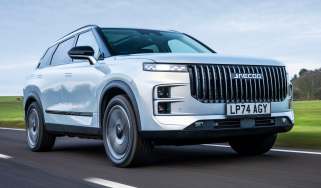Used Land Rover Discovery review: 2016 to 2020 (Mk5) - Running costs, MPG, CO2 emissions and insurance
The Discovery 5 is a large car that comes with large bills for servicing, insurance, tax and at the pumps
There’s no escaping the fact that you’ll need deep pockets to run a Discovery 5. It’s a very large vehicle and even though it weighs considerably less than its predecessor, it still tips the scales at more than two tonnes – this has a direct bearing on costs because it impacts fuel consumption and in turn the car’s CO2 emissions, which affects how much annual road tax you pay. Weight also has a bearing on how quickly tyres, brake pads and discs wear out. And if the Discovery 5 you buy is comparatively new, you may feel obliged to continue having it serviced by a Land Rover dealer where hourly labour rates are deep into three figures. With an older example, servicing at a respected independent Land Rover specialist will save you a great deal of money.
A 2.0-litre SD4 diesel-powered Discovery 5 has two year/21,000-mile service intervals, while the other diesel and petrol models need to be serviced annually or every 16,000 miles. The cheapest (and therefore most basic) service for the SD4 is around £420, but six years into the car’s life you can expect to pay the other side of £900 for a much bigger service, and at year 10 you’ll be hit with a whopping £1,700 bill. And that’s just for the servicing – it doesn’t include anything else that might need replacing or repairing. For the other models, which need servicing twice as often, a minor service is about £385 – at year six, however, you’re looking at paying £1,000 rising to £1,500 in year seven and then £1,675 in year nine.
More reviews
Some original owners may have purchased a fixed-price servicing plan: if they have, ask if they’re prepared to transfer it with the car when you buy it.
How much do used Discovery 5 models cost?
Such is the Discovery 5’s popularity that you’ll find very few bargains around. The starting point for early examples is in the region of £35,000 for an SE, but if you’re on the hunt for an HSE or HSE Luxury then you should budget for between £40,000 and £60,000 when buying from a car dealer’s forecourt.
What’s it like for fuel economy, emissions and tax?
The Discovery 5’s fuel consumption seemed passable for a vehicle its size using the old way of measuring mpg, but since the introduction of the snappily-named Worldwide harmonised Light-duty vehicles Test Procedure – or WLTP – its figures don’t look so rosy. The WLTP testing method is meant to better represent the fuel economy you might expect in everyday driving, which in the case of the 3.0-litre V6 petrol engine is a mere 16mpg – previously it was 26mpg. The 2.0-litre petrol isn’t much better at 19mpg (previously 30mpg), but at least the diesels manage between 26 and 28mpg (37-46mpg in old money).
When checking the Discovery 5’s fuel consumption against that of rivals, do make sure it’s the WLTP figures you’re looking at to make a fair comparison.
CO2 emissions range from 163g/km for the 2.0 Td4 diesel engine through to 254g/km for the 3.0 supercharged V6 petrol Si6, although the outputs do vary a little depending on what equipment a particular model has and how wide its tyres are. For most versions of the Discovery 5 you’ll be paying £490 annually in road tax, although that leaps to £585 for the Si6. Cheapest models to tax are the Sd4-engined cars at £250 a year, while the Td6 is £315.
How much will it cost to insure?
The Discovery 5’s insurance groups span from group 27 (for the 2.0 petrol) through to 41 (V6 petrol and Sd6 V6 diesel).
















